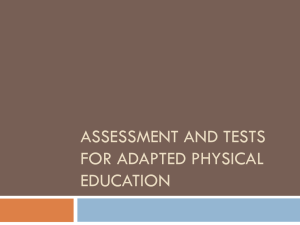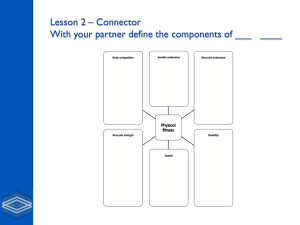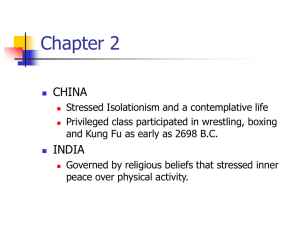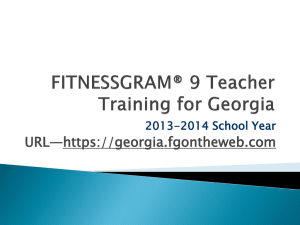FITNESSGRAM Overview - Georgia Department of Education
advertisement
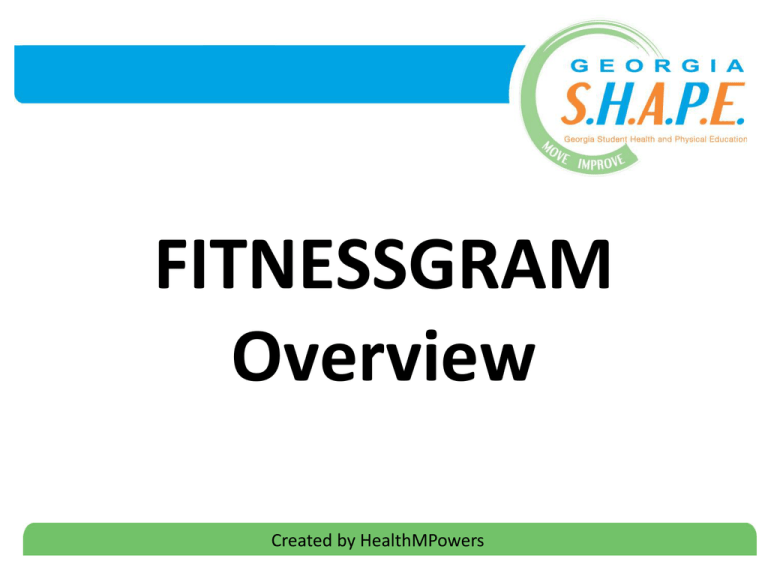
FITNESSGRAM Overview Created by HealthMPowers WHY FITNESSGRAM? Combines both an educational assessment and reporting software program Designed to promote lifelong physical activity Based on the latest research on children’s fitness Health related Uses criterion-referenced standards 2 FITNESSGRAM Advisors Charles L. Sterling, EdD The Cooper Institute FITNESSGRAM Chairman Charles B. Corbin, PhD Arizona State University - Retired Kirk J. Cureton, PhD University of Georgia Scott Going, PhD The University of Arizona James R. Morrow, Jr., PhD University of North Texas Robert Pangrazi, PhD Arizona State University - Retired Russell R. Pate, PhD University of South Carolina Sharon Ann Plowman, PhD University of Northern Illinois - Retired 3 Judith J. Prochaska, PhD University of California, San Francisco Georgi Roberts, MS Fort Worth I.S.D., Fort Worth, Texas Weimo Zhu, PhD University of Illinois at Urbana-Champaign Dolly Lambdin, EdD University of Texas at Austin Matthew T. Mahar, EdD East Carolina University Marilu D. Meredith, EdD The Cooper Institute Project Director Gregory J. Welk, PhD Iowa State University Scientific Director FITNESSGRAM Philosophy 4 H = Health and health related fitness E = Everyone L = Lifetime P = Personal Georgia’s Philosophy & Goals See DOE Information Section in training manual Philosophy: The acquisition of knowledge related to students' health related fitness levels is vital to the development and implementation of strategies focused on personal health improvement and enhanced readiness for learning. Goals: To improve the health related fitness levels and therefore health outcomes of students. To develop students who are active now and for a lifetime. To develop students who are able to self assess health-related fitness levels, interpret fitness test results, set goals, and motivate themselves for personal fitness improvement. To provide longitudinal data on the status of the health-related fitness of Georgia students through systematic assessment, data collection, monitoring, and reporting. To use fitness assessment data to inform policy, program, curricular, and instructional decisions for P-12 physical education at the school, district, and state levels. 5 Process vs. Product If we do the process the product will follow! Physical activity is the process. Physical fitness is the product. 6 Differences in Fitness Assessments FITNESSGRAM OTHERS Health related Skill related Norm-referenced Often used for grading because of percentiles Award driven Provides scores, awards, but no recommendations for improvement Criterion-referenced NOT used for grading Personal improvement driven Provides individualized feedback Encourages self assessment or individualized assessment 7 Criterion-Referenced vs. Norm-Referenced Criterion-referenced standards are associated with good health and based on scientific information. Normative standards are comparisons relative to others in a group but do not provide information on how the values relate to health. FITNESSGRAM is Criterion-Referenced. The established standards for good health are called Healthy Fitness Zone. 8 Percentage of Students in Healthy Fitness Zone Physical Fitness Assessment Grade 5 Grade 7 Grade 9 Aerobic Capacity 60.2% 60.5% 52.4% Body Composition 67.4% 67.0% 68.0% Abdominal Strength 80.6% 83.1% 82.6% Trunk Extension Strength 88.2% 89.3% 86.3% Upper Body Strength 67.1% 68.7% 69.5% Flexibility 66.6% 72.4% 70.3% 9 Two Components FITNESSGRAM • Fitness assessment and reporting system ACTIVITYGRAM • Physical activity recall tool • Use of ACTIVITYGRAM is up to individual schools and districts 10 Courtesy of Human Kinetics. FITNESSGRAM Testing Options Self Testing • Student learns to test self • Takes time to teach • Good education; serves students for a lifetime Individualized Testing • For personal information • Can be conducted by student, or with assistance from a partner, parent or teacher 11 FITNESSGRAM Testing Options Institutional Testing • Administered by a trained person • Provides more accurate results to parents and others • Takes time Personal Best Testing • See how well interested students can perform on each assessment • Takes a lot of time • Recommended use after school or voluntary • Focus is more on performance as opposed to health 12 Institutional Testing Guidelines Take steps to insure confidentiality of assessment results Take care in interpreting results Take care in generalizing pre- and post-assessment data Consider nutrition and other factors Take care in accurately reporting assessment results 13 FITNESSGRAM Software Web-based Generates individual student/parent reports Provides suggestions about how to promote good fitness Generates group reports for State reporting Allows for tracking of students’ fitness throughout their school years 14 Reports Software generates: Individual Reports • Comparison to HFZ • Recommendations Group Reports Courtesy of Human Kinetics. 15 Appropriate Uses of FITNESSGRAM Facilitates fitness education • Evaluating personal fitness levels • Goal setting • Program planning and tracking Provides feedback to students and parents Allows personal tracking • Annually and over time Can guide PE program planning 16 Inappropriate Uses of FITNESSGRAM Using scores for grading Using scores to evaluate teacher effectiveness Using scores to evaluate overall physical education program 17 Confidentiality Confidentiality of results is important! Appropriate protocol must be used to ensure proper privacy. Educate students on the importance of confidentiality of fitness assessment results. 18 FERPA The parties will safeguard the confidentiality of the student data as required by the Federal Family Educational Rights and Privacy Act (FERPA) and other applicable laws and regulations. No release of data, reports, information, or output of any kind based on the data will include any information that could be identifiable or linked to a specific person. 19 FITNESSGRAM Resources http://www.cooperinstitute.org/index.cfm http://www.fitnessgram.net/home/ Scientific Reference Guide http://www.doe.k12.ga.us/ci_services.aspx?PageReq= CIServHealthPhys Georgia Department of Education – Health and Physical Education http://georgiashape.org 20

